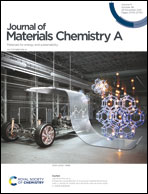Ultra-long KFeS2 nanowires grown on Fe foam as a high-performance anode for aqueous solid-state energy storage†
Abstract
The development of low-cost and high-activity Fe-based anodic materials is very promising for the present solid-state energy storage. In this work, we successfully synthesize ultra-long KFeS2 nanowires on an Fe foam substrate via a simple hydrothermal strategy. Physical characterization shows that the as-synthesized KFeS2 nanowires possess merits of good morphological uniformity, considerable mass loading (∼76 mg cm−2) and strong affinity for the substrate. As an anode for solid-state energy storage, the areal capacity of the KFeS2 electrode can reach 21.1 mA h cm−2 (at 50 mA cm−2), which is greatly enhanced as compared to the previous best result (<2 mA h cm−2), and the durability test indicates that the electrode only shows a small working potential shift after long-time cycling. The assembled KFeS2//NiO single solid-state battery exhibits an enhanced energy density of 175.2–135.8 W h m−2 at a power range of 436.5–1750 W m−2. By using in situ Raman and in situ electrochemical impedance spectroscopy (EIS) technologies, the dynamics of the electrode and the energy storage mechanism of the KFeS2 nanowires are revealed. This work achieves a milestone in the development of high-performance Fe-based film anodes for solid-state energy storage, especially aiming for low-cost and large-scale application.



 Please wait while we load your content...
Please wait while we load your content...